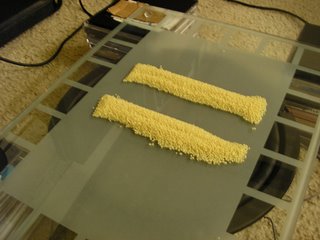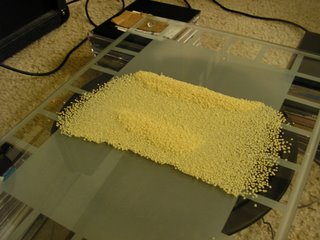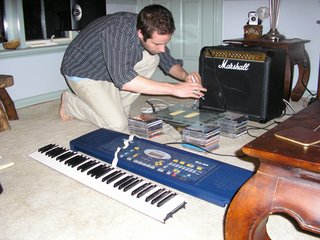After a month long absence from my Masters research, I've decided to get back to it focusing on a Lucier work called Queen Of The South. The work explores responsive surfaces and strewn materials, examining how the activation of a surface (through the use of sine waves) can move materials around - creating formations and patterns.
The picture above shows me setting up a trial - the keyboard is set to play sine tones, which are sent to the amplifier then to a loudspeaker which sits beneath a glass plate suspended just above the speaker cone's rim. A sine tone is then played which resonates the glass surface causing the strewn materials (in this case, cous cous) to move around.


I experimented with a number of formations, finding that the most resonant frequency with the glass surface was an E2 sine tone (82.4 Hz).
Here are a couple of images showing an initial formation and its altered state after the tone had been played for about ten seconds. It's not the most visually stimulating example, but it deatials the simple effect that the resonating surface can have on the strewn materials. Also this was with just one louspeaker, once I can find a larger piece of glass (or otherwise) I'll begin testing the process with multiple speakers. This has led me to a couple of simple conclusions:
1) Frequency must resonate surface (pretty obvious, really).
2) End formations of strewn materials also dependent on:
(i) nature of materials (cous cous, rice, sugar, dirt, sand, coffee grains)
(ii) density of materials (clumps, piles, sparse)
(iii) placement of speaker[s]
(iv) resonance/excitement of surface.
There is a variation of this setup where contact mics (or piezos) are attached directly to the surface, I will experiment with this also over the next week.
***
With regard to the research writing, I am preparing a proposal for my presentation in late August. As detailed in previous posts (see March/April/May archives) I have a rough outline of the topic, though an argument and discussion hasn't been apparent to me until recently. I have decided to examine perspectives on experimental music, specifically in relation to Lucier's work. This will include a commentary on experimental music using sources and arguments derived from composers and writers such as John Cage, Morton Feldman, James Tenney, Brian Eno, Steve Reich and Douglas Khan.


2 comments:
Here are some links that I believe will be interested
Keep up the good work. thnx!
»
Post a Comment